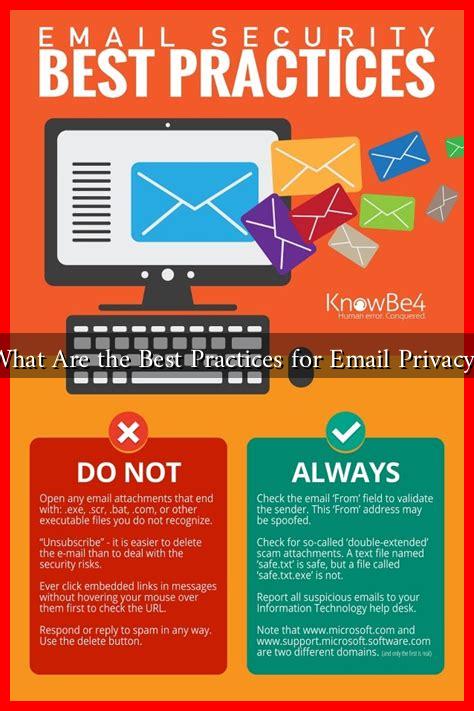-
Table of Contents
- What Are the Best Practices for Email Privacy?
- Understanding Email Privacy Risks
- Best Practices for Email Privacy
- 1. Use Strong Passwords
- 2. Enable Two-Factor Authentication (2FA)
- 3. Be Cautious with Public Wi-Fi
- 4. Regularly Update Software
- 5. Be Wary of Suspicious Emails
- 6. Use Encrypted Email Services
- Case Study: The Impact of Email Privacy Breaches
- Conclusion
What Are the Best Practices for Email Privacy?
In an age where digital communication is ubiquitous, email remains a primary mode of interaction for both personal and professional purposes. However, with the increasing prevalence of cyber threats, ensuring email privacy has never been more critical. This article explores best practices for maintaining email privacy, providing insights and actionable steps to protect your sensitive information.
Understanding Email Privacy Risks
Before diving into best practices, it’s essential to understand the risks associated with email communication. Cybercriminals employ various tactics to compromise email accounts, including:
- Phishing Attacks: Fraudulent emails that trick users into revealing personal information.
- Malware: Malicious software that can be delivered via email attachments or links.
- Data Breaches: Unauthorized access to email accounts due to weak passwords or security vulnerabilities.
According to a report by the Cybersecurity & Infrastructure Security Agency (CISA), 90% of data breaches start with a phishing attack. This statistic underscores the importance of implementing robust email privacy practices.
Best Practices for Email Privacy
To safeguard your email communications, consider the following best practices:
1. Use Strong Passwords
Your email password is the first line of defense against unauthorized access. Follow these guidelines to create a strong password:
- Use at least 12 characters, including uppercase and lowercase letters, numbers, and symbols.
- Avoid using easily guessable information, such as birthdays or common words.
- Change your password regularly and do not reuse passwords across different accounts.
2. Enable Two-Factor Authentication (2FA)
Two-factor authentication adds an extra layer of security by requiring a second form of verification, such as a text message or authentication app. According to Google, 2FA can block 100% of automated bots and 96% of phishing attacks.
3. Be Cautious with Public Wi-Fi
Accessing your email over public Wi-Fi networks can expose you to security risks. If you must use public Wi-Fi, consider the following:
- Use a Virtual Private Network (VPN) to encrypt your internet connection.
- Avoid accessing sensitive information or logging into accounts.
4. Regularly Update Software
Keeping your email client and devices updated is crucial for protecting against vulnerabilities. Software updates often include security patches that address known issues. Set your devices to update automatically whenever possible.
5. Be Wary of Suspicious Emails
Always scrutinize emails before clicking on links or downloading attachments. Look for signs of phishing, such as:
- Generic greetings (e.g., “Dear Customer”) instead of your name.
- Urgent language that pressures you to act quickly.
- Unusual sender addresses or domains.
6. Use Encrypted Email Services
Consider using email services that offer end-to-end encryption, such as ProtonMail or Tutanota. These services ensure that only you and the intended recipient can read the contents of your emails, protecting your privacy from potential eavesdroppers.
Case Study: The Impact of Email Privacy Breaches
In 2016, the Democratic National Committee (DNC) suffered a significant email breach that exposed sensitive information and led to widespread political ramifications. The breach was attributed to phishing attacks that compromised the email accounts of key personnel. This incident highlights the importance of email privacy and the potential consequences of neglecting security measures.
Conclusion
Email privacy is a critical concern in today’s digital landscape. By implementing best practices such as using strong passwords, enabling two-factor authentication, and being cautious with public Wi-Fi, you can significantly reduce the risk of email breaches. Additionally, staying informed about potential threats and utilizing encrypted email services can further enhance your privacy. Remember, protecting your email is not just about safeguarding your information; it’s about maintaining your digital identity and trust in communication.
For more information on email security, visit CISA’s publications.

